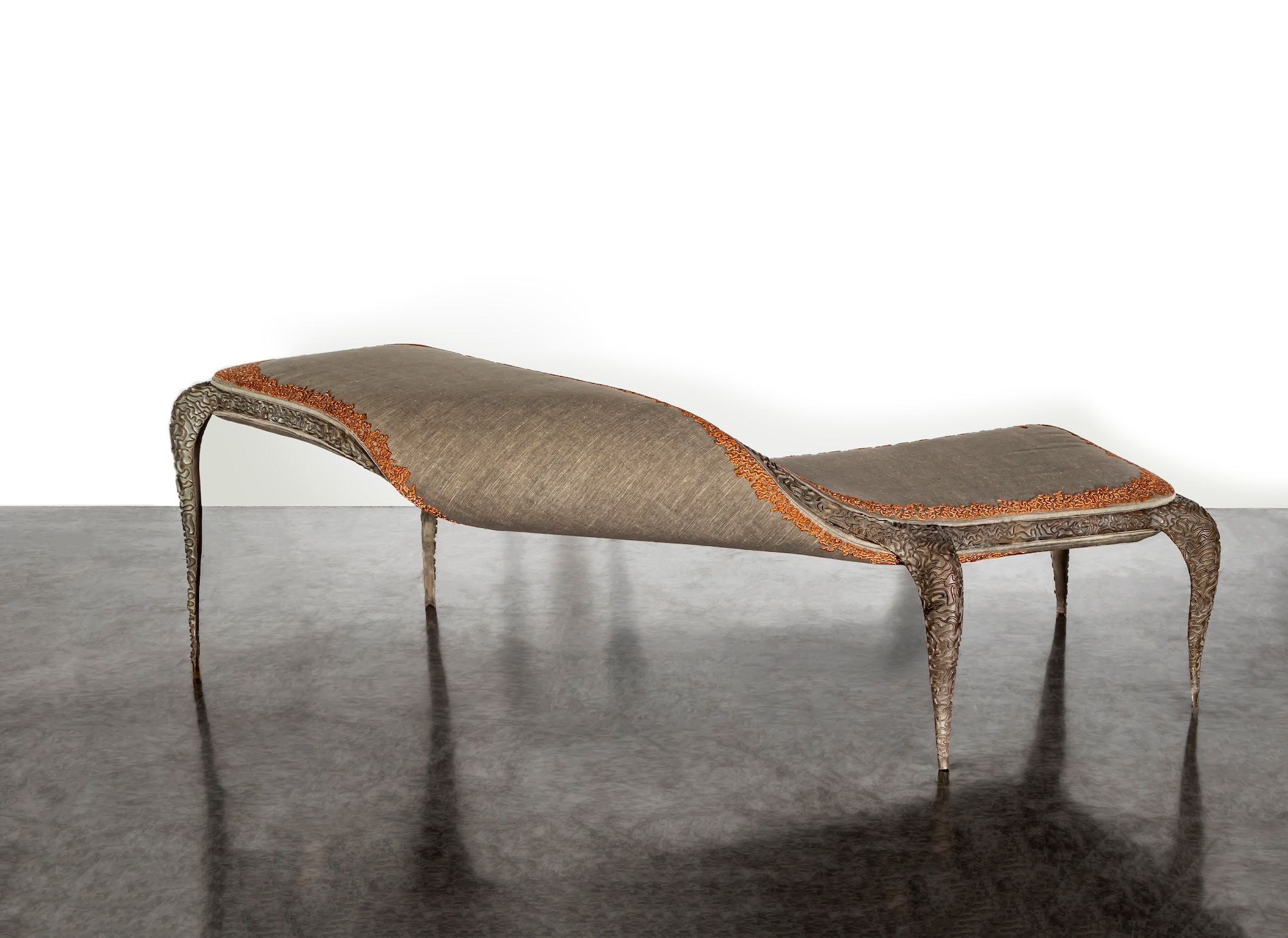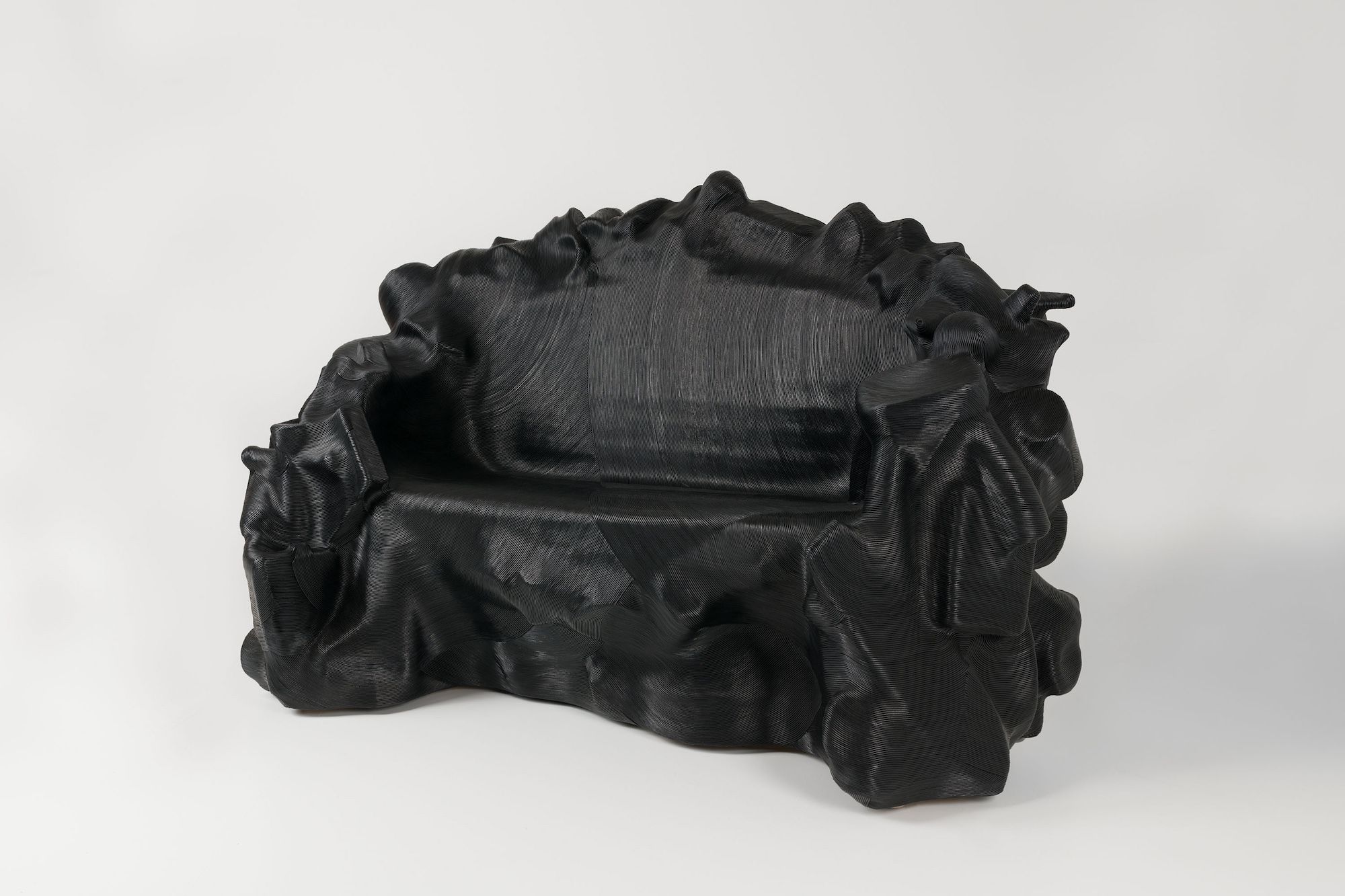DESIGN COLLECTING NOVEMBER 7 2023
by Daniella Ohad
Daniella Ohad recaps her weekly conversations with experts in design collecting

DETAIL OF BANQUETTE BY SEBASTIAN BRAJKOVIC FOR DAVID GILL GALLERY, 2018
Photo © David Gill Gallery
Comprising one-on-one interviews with international experts, Collecting Design: History, Collections, Highlights is a Fall 2023 webinar program hosted by Daniella Ohad for Christie’s Education. For the Design Miami/ Forum, Ohad recaps each conversation. Read on for highlights from her conversation with Switzerland-based designer Sebastian Brajkovic.

DESIGNER SEBASTIAN BRAJKOVIC WITH HIS MATHEMATICIAN #01 CHANDELIER FOR DAVID GILL GALLERY, 2019
Photo © Thomas Stewart; courtesy of David Gill Gallery
One of the world’s foremost experts on design, speaking to me off the record, recently mused that contemporary collectible design can be divided into two main categories: “museum objects” and “decorator objects.” The first category encompasses innovative design responses to political, social, technological issues swirling in the zeitgeist. The second is driven by aesthetics and the power of objects to transform interior spaces.
Sebastian Brajkovic, my recent Collecting Design: History, Collections, Highlights guest, is one of only a handful of international talents adept at crisscrossing such boundaries. His designs—highly sculptural, arresting, and sumptuous forms suffused with metaphysical narratives—are frequently found both in esteemed institutional collections and in the high-profile homes and public spaces prominently featured in the pages of international interior design magazines. Legendary interior designer Peter Marino, for example, placed multiple Brajkovic’s designs in Dior boutiques in London, Washington DC, and Barcelona, a project that Brajkovic called “a dream come true.”

BANQUETTE BY SEBASTIAN BRAJKOVIC FOR DAVID GILL GALLERY, 2018
Photo © David Gill Gallery
Born in Amsterdam in 1975 to a Dutch-Indonesian mother and a Croatian-Italian father, Brajkovic currently works from his home-studio in Switzerland, committed to an individualistic practice independent from the international design scene. Playing with polarities—past vs. future, analog vs. digital, emotional vs. intellectual—he has forged a unique creative identity that is entwined with his need for freedom, resulting in work that seamlessly merges the disciplines of art and design. “I make sculptures,” Brajkovic told us, “but they have to be practical.”
Brajkovic’s practice is, at least in part, a manifestation of the Design Academy Eindhoven’s innovative pedagogy under the leadership of Li Edelkoort. As the Academy's Chairwoman between 1999 and 2008, Edelkoort sought to distance the discipline of design from its modernist, functionalist roots, emphasizing instead a more conceptual, expressive approach that, in turn, helped redefine international design culture more broadly in the 21st century. During her tenure, Edelkoort cemented the Academy’s status as a world-class incubator for design ideas and design talent, where students were pushed to think more deeply and, upon graduation, springboarded into superstar careers.

LATHE V RED BY SEBASTIAN BRAJKOVIC, 2008
Photo © Carpenters Workshop Gallery
Brajkovic attended the Design Academy Eindhoven between 2003 and 2006, mentored by design legends Gijs Bakker, Hella Jongerius, and Jurgen Bey, among others. For his graduation project, he developed Lathe, a distorted 18th-century chair fabricated in wood using a combination of computer software and traditional woodworking tools. Brajkovic explained that the project paid tribute to the lathe, an ancient, rotating woodworking tool that he’s been fascinated with since childhood.
Shortly after graduating from the Academy in 2006, Brajkovic was picked by the newly-launched Carpenters Workshop Gallery. Its founders, Loïc Le Gaillard and Julien Lombrail, took him under their wing to help him navigate the commercial world in the early years of his professional journey. Providing him with a platform to follow his dreams without compromise, they instilled in him a fearlessness and facilitated his pursuit of perfection in both form and craftsmanship.
Le Gaillard and Lombrail also advised Brajkovic to create his Lathe Chair in bronze as a way to make his work “live forever.” The success of the new collection for Carpenters Workshop Gallery inspired Brajkovic to make bronze one of his practice’s signature materials, and he has since forged close relationships with foundries in Spain, Greece, Germany, and Italy. When famed fashion designer Jean Paul Gaultier—well known for his eye for emerging talent—acquired Brajkovic’s Lathe V Brown in 2007, the rising-star designer knew he was on the right track. He has since expanded the Lathe collection to include aluminum as well.


SEBASTIAN BRAJKOVIC'S GARNIER CHAIR, 2022, AND DANCING QUEEN CANDELABRA, 2022, FOR BOTH DAVID GILL GALLERY
Photos © David Gill Gallery
Employing both digital and handcraft techniques, Brajkovic’s designs take months to develop and at least a year to complete—such as his exceptionally elegant Fibonacci Chair, which seems more like a treasured, finely crafted relic of Louis XVI’s court than a contemporary design object. Beyond its carved frame, the Fibonacci features a lush linen upholstery embroidered with copper and silver threads. The textile was handcrafted by haute couture embroidery atelier Maison Lesage, well known for working for couturiers like Chanel, Balenciaga, and Schiaparelli. Brajkovic favors rich details that can only be achieved by the human hand while also embracing the sculpting precision of machines, demonstrating the soulfulness that is possible when the two are choreographed together.
Looking back over his nearly two-decades-long career, it’s clear that Brajkovic’s style has evolved, growing more sophisticated year over year, from exhibition to exhibition, reflecting the influence of his visionary mentors, from Jongerius at the Design Academy and Le Gaillard and Lombrail of Carpenters Workshop, to his current gallerist David Gill. From the beginning, Brajkovic has sought to stretch the formal language of furniture by bridging the antique with the contemporary. Today, under Gill’s guidance, his forms have become even freer—more complex, abstract, and unexpected.

APEIRON CONSOLE BY SEBASTIAN BRAJKOVIC FOR DAVID GILL GALLERY, 2022
Photo © David Gill Gallery
Recently, following years of digital experimentation, Brajkovic has returned to modeling his forms in clay, eschewing the software that defined his earliest work. This kind of handwork, he said, affords him the freedom to devise more novel forms. The computer has its strengths, he said, but can also obscure the trace of the artist's thought process.
As our conversation concluded, Brajkovic noted that collaborating with Gill has brought a new level of freedom and opportunity that feels like a special privilege. For last year’s Platinum Jubilee of Elizabeth II, Gill invited Brajkovic to contribute work to an exhibition marking the historic occasion, which resulted in Brajkovic’s intricate Dancing Queen candelabra. New week, David Gill Gallery will open a solo exhibition that celebrates Brajkovic’s shifting emphasis toward working by hand. Afterall, he acknowledged, our hands are the best way to achieve design greatness. Whatever balance he may choose to strike between design idioms of the past, present, and future, we can be sure that Brajkovic will achieve something original, something we’ve never seen before.
To watch Ohad’s Collecting Design: History, Collections, Highlights webinar program live, register here.


